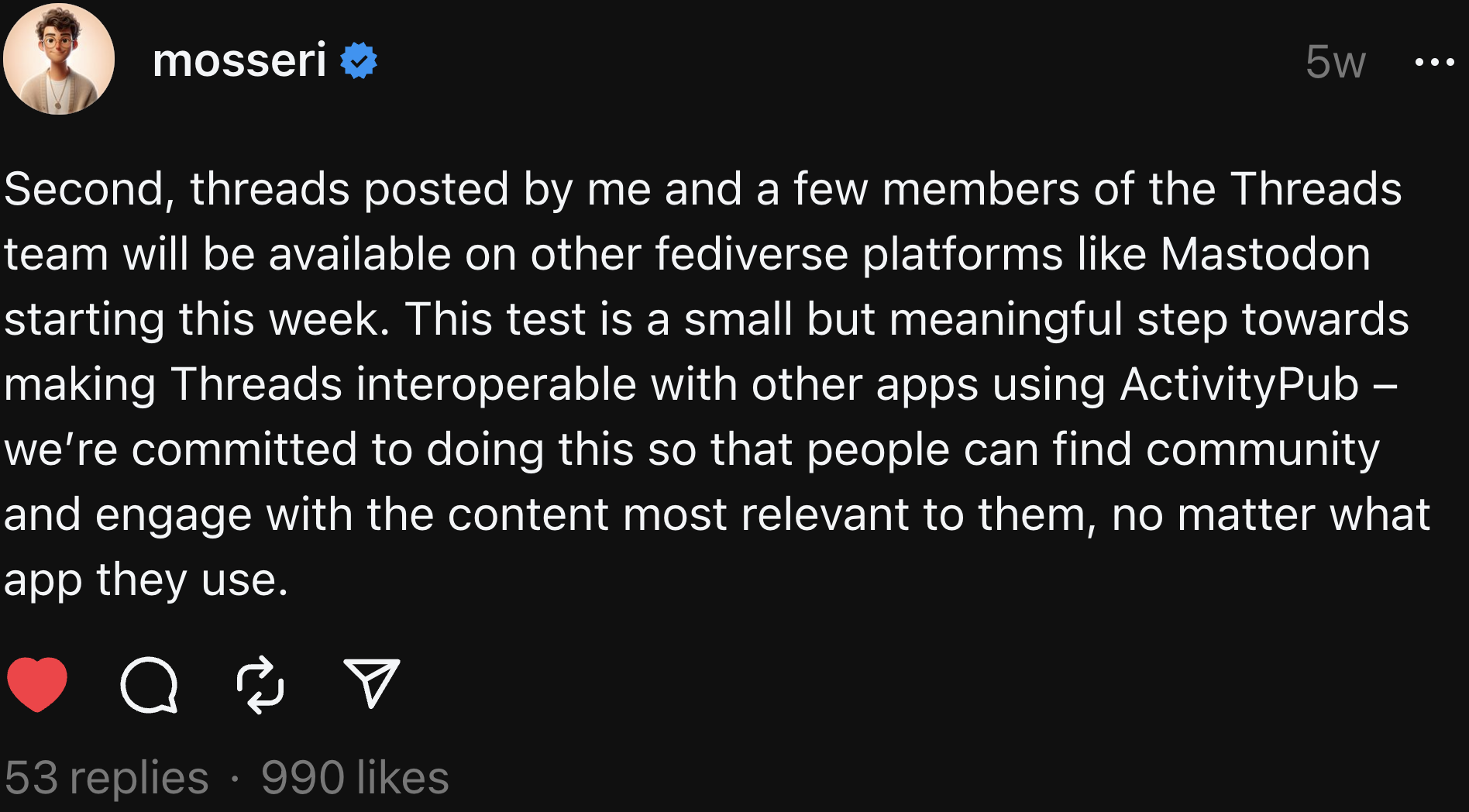Pavel Larionov

Beyond Centralized Social Media: How Open Protocols are Reshaping Internet

Introduction
The last few years have been marked by several changes in the social media landscape: Twitter’s acquisition by Elon Musk and its rebranding to 𝕏, Threads announced by Meta, and Jack Dorsey, founder of Twitter, creating BlueSky (which is now available for everyone without invite codes). While some major players want to preserve control and provide service single-handedly, others are embracing the decentralized approach. This latter fact has already begun to make waves across the industry, beyond social media.
What does WordPress have to do with decentralized media? What is the Fediverse in the first place? Why do major tech giants like Meta consider adopting a decentralized approach? Let’s find out.
Understanding the Fediverse
Let’s start with the most confusing term, because it’s crucial for understanding what is happening – the Fediverse – which is short for “federated universe.”
The Fediverse is a network of independent servers (also called instances) that store and serve content to users. Users have a choice of which server to join, each with a certain set of rules. So, there is no single organization that decides for everyone; instead, users are able to choose an instance with a suitable set of rules, while still being able to interact with people on different servers.
The servers across the Fediverse offer diverse web services, including social networks and blogs, and communicate through protocols like ActivityPub or the AT Protocol. This unique architecture empowers users with data control while ensuring a cohesive social media experience.
A popular misconception about decentralized protocols is that they are based on blockchain. While this can be technically achieved, in the case of the Fediverse, we are not talking about blockchain as no popular protocols are based on blockchain.
Congratulations, you now know more about the Fediverse than the majority of people on Earth.
The Role of ActivityPub
Now that we know what the Fediverse is and isn’t, let’s dig deeper into how it works with an example of ActivityPub. It will get a little technical, but bear with us as this knowledge will provide you with a great understanding and hence more profound decision-making.
ActivityPub is currently the most popular protocol in the Fediverse. It uses a JSON-based structure for data representation and operates on two levels: Client to Server (C2S) and Server to Server (S2S). As you might have guessed, C2S interaction allows users to engage with their servers, while S2S facilitates inter-server communication, enabling a federated network. ActivityPub categorizes entities as “actors” (like user accounts) and “objects” (like posts), with activities generated based on interactions between these entities.
Bluesky and the AT Protocol
But humanity can’t just have a one-size-fits-all solution, as we have free will, which pushes us to have our own set of priorities – and that’s okay. This is how another decentralized protocol emerged – the AT Protocol, created by Bluesky.
Bluesky, a decentralized social app conceptualized by former Twitter CEO Jack Dorsey, is behind the creation of the AT Protocol. The service was operating on an invite code basis until very recently; now, registration is open for everyone, and the process of getting onboarded is very straightforward. The AT Protocol, which powers Bluesky, offers account portability (a feature lacking in ActivityPub), which means that users can seamlessly migrate across different platforms within the network, maintaining their followers, data, and identities. Another prominent feature differentiating the AT Protocol from the competition is the ability to create custom feeds with pre-programmed rules. For example, users can create a custom feed of people they follow but only see posts with images. These feeds can be shared, so to stay on the previous example – anyone who is adding this custom feed to their account will see the feed of people the user is following, so the content in those feeds can be dynamic based on the user. This is differentiating the custom feeds on AT Protocol from the user-created lists on 𝕏 platform, which display the same content for all users who follow the list.
The fact that another protocol was created reflects a growing enthusiasm for decentralized models in social media.
Comparing Decentralized Fediverse Protocols: ActivityPub vs AT Protocol
While ActivityPub has established itself as the standard in the Fediverse, the emergence of the AT Protocol introduces new capabilities, particularly in portability and user autonomy. However, the long-term impact and adoption of the AT Protocol in the broader landscape of decentralized social media are yet to be fully realized.
As we are all about facts and being on-point, here is a high-level comparison of features.
– Main Purpose:
AT Protocol: Customizable, federated protocol.
ActivityPub: Federated social networking.
– Account Portability:
AT Protocol: High emphasis on portability.
ActivityPub: Limited portability.
– Feed Customization:
AT Protocol: Highly customizable feeds, allowing complex, tailored feed structures.
ActivityPub: Standardized feed structures with limited customization options.
– Data Management:
AT Protocol: Implements signed data repositories and Decentralized Identifiers (DIDs) for enhanced security and identity management.
ActivityPub: Standardized approach, less complex.
– Customization:
AT Protocol: Highly flexible for complex requirements.
ActivityPub: Basic, standardized customization.
– Discovery:
AT Protocol: Large-scale search and discovery.
ActivityPub: Hashtag-style discovery.
– Technology Base:
Both are federated, not blockchain-based.
It seems like the AT Protocol is more technologically advanced than ActivityPub, which is to be expected as the AT Protocol is younger and could learn from its competitors’ mistakes. But time will tell which protocol will grab the most attention, as adoption is what matters most in the end.
Who’s Adopting the Fediverse?
As words do not exist without meanings, technologies can’t thrive without real-life products based on them. So, let’s talk about which services are using these decentralized technologies so that we can recognize a Fediverse when we see one.
Mastodon: Redefining Social Media
Mastodon stands as a prime example of the Fediverse’s principles, offering an alternative to mainstream social media with user-centric control.
Meta’s Leap into Decentralization
Meta’s announcement to integrate Threads with Mastodon reflects a significant industry shift towards decentralized protocols. While this process has not finished yet, it has definitely begun.
Currently, only selected accounts from Threads are visible on Mastodon, and they show as having the @threads.net instance on accounts, like Adam Mosseri (head of Instagram at Meta), who posted this:
And here is how the same post looks on Mastodon:
WordPress: Joining the Decentralized Wave
Automattic, the company behind WordPress, also announced their intention to join the Fediverse.
WordPress.com, through its integration with the ActivityPub plugin, has bridged the gap between traditional blogging and the Fediverse. It might seem surprising for a rather conservative CMS provider to make such a bold move, but this enables WordPress users to seamlessly connect their blogs to a wider range of federated platforms, allowing content sharing and interaction across diverse social networks.
Basically, it makes content hosted on millions of WordPress-based websites (the company claims to power 40% of all websites on the internet) much more visible and interactive than ever before. This development marks a significant step in enhancing cross-platform engagement and content visibility in the decentralized web space.
Why are Major Tech Giants Interested in Decentralization of their Services?
WordPress’s integration with ActivityPub and Meta’s exploration of the Fediverse represent strategic responses to the evolving digital landscape. But why would they? On the surface, these moves seem to aim to enhance user engagement and content reach naturally and regardless of the platform users are selecting. Then, they might be experiencing the urge to adapt to the trend towards decentralized networks, as more users demand transparency and liquidity in the social media domain. Besides that, corporations are facing growing demands for data control and privacy from both the user base and regulators; this step might be preventative to future-proof their existence as corporations might be concerned that regulators will force them to open their algorithms on uncomfortable terms.
The consideration of the network effect might be another significant factor for joining the open protocol. By definition, the network effect creates a cycle of growth and value addition, where each new user enhances the platform’s value not just for themselves but for all existing users. Now, the network effect can be applied at higher abstraction levels – to the whole social media service as part of the Fediverse: with every new service joining the Fediverse, more services will consider joining, and, consequentially, more users will be more inclined to join this larger community, rather than to participate in a closed-source walled garden.
In conclusion, by embracing open-source, federated models, tech giants are positioning themselves to leverage future technological developments and diversify social media interactions. This shift indicates a recognition of the value in community-driven innovation and the need to stay relevant in a rapidly changing online world.
Hyperinteractive’s Experience with WordPress
At Hyperinteractive, we have extensive experience with WordPress, having created innovative digital experiences for a diverse range of clients. Take our latest project – an innovative adaptive website for a groundbreaking company voraus robotik – in which we merged traditional CMS with the most advanced technology of our time – AI.
Our expertise positions us to explore the potential of WordPress in this new decentralized landscape. You want to discuss even more exciting possibilities? Let’s talk!
related projects
We are working on intelligent solutions since 2017. We are experienced with custom solutions as well as all the tools AI. These are just three example cases.











